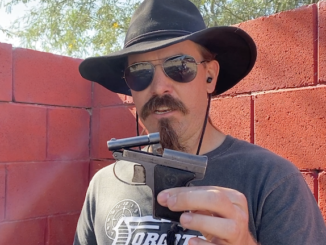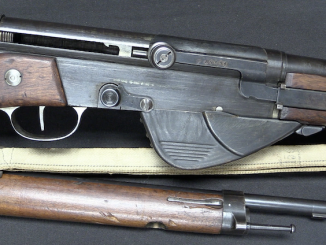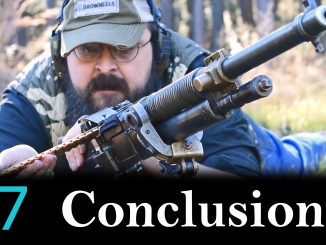My book is now in stock and shipping! Order your copy today!
The PGMP (Poignée Garde-Main Polyvalente) handguard assembly is the original modification to allow mounting of optics to the FAMAS rifle. The FAMAS handguard was not designed to hold an optic, and is not nearly stable enough to retain zero. The PGMP adds a hefty metal block to secure the optics rail to the body of the rifle, and also includes a mounting point for a laser designator or other accessory on the side of the handguard. These are used with a variety of optics in French military service, including Scrome 4x scopes and EOTech holographic sights (the Army is purchasing Aimpoiint CompM5 red dots for the new 416F rifles). The Scrome is extremely rare in the US, so I chose to set it up with an EOTech. It has a very high cheek weld (chin weld, really), but it does work alright.
Today’s match is a two-main team setup, where booth shooters engage different sets of targets simultaneously, and the team’s time ends when both sets of targets are neutralized. On the handgun section (the second half of each stage), the faster shooter can help complete his partner’s targets is opportunity allows.
Thanks to Jordan for joining me for this match, as Karl was not able to attend.




Ian’s new “Wanted” ad for all the high-tech FELIN gadgetry:
https://modernfirearms.net/en/bez-rubriki-en/famas-eng/
https://twobirdsflyingpub.wordpress.com/upgraded-famas-felin-eurosatory-2014-jpg/
I note that the FAMAS rifles reconditioned (by Beretta?) have the top handle between the foresight and back sight removed so the red dot can be mounted just a tad lower… On the other hand, the “chin weld” seems the only option for all the FELIN wizardry with its TV-remote control/ gamer control as front fore grip, no?
With removed handle, as you point out, and modified cocking handle ala G36, the ‘famed’ FAMAS could have lived on long time. It would also reduce overall bulk. It is otherwise quite capable rifle.
What we see on Ian’s version is just too far from desirable.
I am interested that the FAMAS used the Kiraly lever-delayed blow back system, used on the celebrated-by-gun-nerds but ultimately rejected German Aleksandervich Korobov TKb-517, which it turned out, was apparently quite ammunition sensitive?
I think critics of the FAMAS have complained about its use of non-Nato standard steel cased ammunition? Further, three-groove rifling is pretty darn interesting, and France’s Armée de Terre adopted it in, what, 1978 just four years before Nato adopted the SS109/M855 62gr. 5.56mm cartridge, and with it, the M16 STANAG magazines, yes? Faint echoes of Mark Twain’s dictum “History may not reapeat, but it sure rhymes a lot” in that the M1886 Lebel 8x50R m/m cartridge had revolutionary smokeless properties, but the rifle to fire it did not, and the cartridge almost immediately became obsolete, militating against more efficient small arms designs, witness the much-maligned CSRG Mle. 1915 Chauchat! In the case of the FAMAS, the versions that have been rebuilt have 1 turn in 9-in. rifling to use either the old M193 55gr. or the Nato 62gr. bullets with equal facility, but what of those not updated?
Unlike in WWI, however, when France could hardly have contacted Oberndorf am Neckar and requested the then ubiquitous Mauser bolt-action, now France in the EU and sort of grudgingly in Nato with Germany while advocating a Euro-armée of sorts has figuratively done just that, and will get a bunch of German product-improved versions of the U.S. Stoner-derived AR/M16/M4 in the form of the HK416?
I’m very gratified that the Ian M’Collum book on French service rifles is shipping! I look forward to reading it, and seeing many of my understandings overthrown or at least hugely modified.
Kiraly’s design was intended for cartridges with lower pressure (basically extended pistol cartridges). FAMAS actually does work (at least during my session with it) with standard NATO brass ammo. From several hundred rounds we did not experience one stoppage due to ejection. This was semi-auto civilian version.
Historically this, the AAT52 and Kiraly’s carbines were only infantry weapons fielded in large number based on this concept. Apparently finicky designs when comes to wider ammunition variety and state of contamination.
Ah-ha! Fortuitously, my book arrived and I know now the reason for the steel cased ammo, and just as you say, brass case ammo works good and is even used by one group fielding the FAMAS… I’ve been disabused of much else in my erroneous understanding besides that too!
Great work!
“…I know now the reason for the steel cased ammo…”(С)
I wonder why?
I have heard about very rare, but nonetheless, cabooms when using brass.
Although it is possible, someone mistakenly used the M855 instead of the M193?
I had no hint of a problem, although I did not have the opportunity to release a significant number …
I did NOT like in riginal Bugle, the bolt, or rather, its microscopic details that need to be swapped to change the direction of ejection.
Surely, according to French charters, a certified gunsmith should do this.
“(…)finicky designs when comes to wider ammunition variety(…)”
That being said French forces tested 12,7×99 mm machine gun utilizing this principle – called MAC 58 http://www.smallarmsreview.com/display.article.cfm?idarticles=1346
but was no mass produced as they already have U.S. M2 machine gun in service (which I suspect were also cheaper as surplus)
“(…)TKb-517(…)”
TKB-517 (stands for adjective(Tula) Construction Bureau).
“(…)was apparently quite ammunition sensitive?(…)”
Certainly more than direct competitor, which would become AKM.
“(…)four years before Nato adopted the SS109/M855 62gr. 5.56mm cartridge(…)”
According to Towards a “600 m” lightweight General Purpose Cartridge available here http://www.quarryhs.co.uk/miltech.htm
French in 1970s were interested in extending reach of 5,56 mm but found that due to limit of overall length it could not be achieved. Due to that they decided to keep bolt-action precision rifles for keeping ability of engaging target at greater distances than M193 allowed.
(page 30)
Perhaps there is a good reason why Russians generally do not change very much unless the situation calls for something drastic: “If better product can be made with existing tooling, why reinvent wheel?” The tooling for making AK rifles was plentiful (thus the AKM was easier to make than its competitors) and changing up all factories to make a supposedly cheaper product (like the aforementioned Korobov TKB-517) would cost more in bulk (getting new tooling is NOT a cheap thing!). Did I mess up?
Certainly with the 5.45x39mm cartridge and the AK-74 the accuracy and “dispersion” were improved using the same basic design.
Actually AKM provided more controllable full-auto fire than earlier AK, than to introduction of замедлитель срабатывания курка (not sure about correct U.S. term for that) and new muzzle device.
“(…)Armée de Terre adopted it in, what, 1978(…)”
More I read about general technology history, more I am inclined that dwellers of France were apt to make new inventions, but much less to advertise/sell it abroad. Just look at this: https://interestingengineering.com/45-of-the-greatest-french-inventions-of-all-time
how many of these you would recognized as made first in France?
Honestly, Daweo, and not to brag or anything, but the only French/ Gallic invention on that list–and it is a cool list!–that really surprised me or made me slap my forehead and say: “Sacre bleu! C’est français!” was the etch-a-sketch… Some in the list really are quite well-known, I’d expect.
For anyone still waiting on Ian McCollum’s French rifle book: It is “Tres magnifique” and you are in for a real treat and lotsa knowledge coming your way!
“(…)Unlike in WWI, however, when France could hardly have contacted Oberndorf am Neckar and requested the then ubiquitous Mauser bolt-action, now France in the EU and sort of grudgingly in Nato with Germany while advocating a Euro-armée of sorts has figuratively done just that, and will get a bunch of German product-improved versions of the U.S. Stoner-derived AR/M16/M4 in the form of the HK416?(…)”
Could be ubiquitous Mauser bolt-action chambered for peculiar-shaped 8×50 R cartridge AND work reliable? As side note, late in Great War common heavy tank was produced to be used by France, Great Britain and U.S.A. namely Liberty:
https://tanks-encyclopedia.com/ww1/USA/Mark-VIII-Liberty.php
it did not save combat in that conflict, as war ended when production was ramped up, but shows that international weapon procurement might be older than you might think.
Let’s see here, the French Defense Ministry can hardly afford to be picky at this time. With practically no emphasis on training new gunsmiths or arms designers for service rifles, it is very unlikely that the French Army will pull a successful domestic design out of some magician’s hat. Owing to the FAMAS being used far beyond its projected service life and owing to the issue of suitable replacement weapons not being found on the French firearms private sector (assuming any private sector still exists), is it any surprise that the French are now obliged to import guns from Germany and perhaps from Belgium? Yes, this is just an exaggeration of events.
“(…)Germany(…)”
Keep calm, foreign weapon procurement is mutual, when France adopt HK416, Germany bought ENFORCER by MBDA:
https://www.mbda-systems.com/product/enforcer/
Enforcer has been under contract for Germany since December 2019. The contract will fulfil the German requirement for a lightweight, day/night, precision-guided weapon system with an effective range of more than 1,800 m.
(MBDA was created from Matra)
Ah yes… And the 12 cylinder engine was for both the monster Liberty tank, and for use in aircraft.
Also not seeing combat in WWI was the John Pedersen-designed “U.S. pistol, caliber .30 Model of 1918” aka. the über-ultra-secret Pedersen device, which while scrapped in the United States, served as the basis for the 7.65x20mm long pistol and smg service cartridge! The most effective U.S. aircraft in WWI were French: SPAD XII.
My point was the French were too quick to adopt smokeless powder in a cartridge like8x50 R mm, and then could not do anything with it but make ad-hoc designs like RSC-17 and CSRG Mle. 1915, which were “good enough” even if not the cutting-edge designs the French had up their sleeves–so to speak==like the Meunier, etc. By the time the 7.5x54mm came out, they had an excellent LMG in the FM 1924-29 and worthy bolt-action in the MAS Mle. 1936, but most French troops in 1939 still had the 8×50 R mm Berthier Mle. 1916! So early adoption set the Armée de Terre back from a rimless cartridge and a top-tier repeating rifle, and hindered MG designs… Fast forward, and while it was eminently reasonable to adopt 7.5mm over, say, 7.62x51mm like the rest of Nato did, the adoption of 5.56x45mm before any other Nato nation implied adoption of the M193 55gr. while the UK was tinkering with the 4.85mm and Germany with the “Kraut fresser space magik” 4.9mm caseless Geh-Elf G11, such that when Nato adopted the Belgian SS109/ US M855 version of the 5.56x45mm the U.S. could issue the M16A2, Belgium the FNC, Germany left behind with the G3, but eventually with the G36, Spain with CETME-L and later the G36, the Dutch and Danes with the C7 Canadian M16, and so too Canada… Meanwhile the UK had the “as-built” as-issued IW/ L85 / SA80 debacle, France had the FAMAS in a non-Nato version of the 5.56x45mm (not that it mattered, apparently), Italy the Beretta AR70/90, etc.
“(…)French were too quick to adopt smokeless powder in a cartridge like8x50 R mm,(…)”
HALT SOFORT. Is not that view example of opportunity cost fallacy? Or plain hindsight? I would not say that high-capacity box magazine were obvious back future direction in development in fire-arms area back in 1886.
I fail to see how an appraisal of the James Paris Lee and John Lee patents and inventions of a box magazine, irrespective of its capacity, in *1879* could have failed to impress upon designers in *1886*? The Lebel Mle. 1886/93 was just the thing in comparison to the Kropatschek and Mauser 71/84, or for that matter, the high-capacity 12-shot Swiss Vetterli bolt action 10.4mm small-bore black powder rifle. By 1888, zee Boche had gone for Mannlicher-type en bloc clips. The Swiss didn’t have smokeless, but were in possession of a twelve-shot magazine rifle by 1889. Other powers, greater and lesser rushed to adopt new service rifles, and few, if any, utilized a tube magazine. The French army, as noted in Ian McCollum’s newly-released book, recognized the inadequacies of the system for cavalry and other troops not confined to trudging in boots, and by 1890 had a three-round Mannlicher-type en bloc clip, which was certainly much better than a single shot, but was limited to three shot capacity by the, rush to adopt smokeless powder without enough time to suss out a superior cartridge design, yes? It would be the 1886-1904 run of 8-shot Lebel service rifles and the French army’s “accidental rifle,” the Berthier 3-shot 07/15 that would do the bulk of the service rifles work in WWI (admittedly, outclassed by artillery, machine guns, and for all I know, even subterranean mining and whatnot…)
The 8x50R m/m cartridge is clever, insofar as it takes the old, heavily-rimmed 11mm Gras cartridge, and introduces two tapers into the case in the course of necking it down to 8mm. This allows for the rims not overlapping in one or another feeding device or magazine. But the shape of the cartridge:
http://www.conjay.com/2085%20WW2%208%20Lebel.jpg
Militates against making magazines that don’t look like the 16-18 shot CSRG Mle. 1915 Chauchat’s or the Hotchkiss MGs feed strips. So I would argue that the “hindsight” about the deficiencies of the cartridge’s design were understood *at the time* by the very institutions that used the cartridge and fielded the arms designed to fire it. By 1915, when the French arsenal system efficiently went about repairing and overhauling 1886/93 Lebels candidly understood to be obsolete, while cranking out prodigious quantities of Berthier carbines and new infantry rifles based on the carbine, trench warfare was relatively new and novel, but still a fact of warfare in northwestern Europe… The Lebel had to be really, really long and fitted with a fearsome epee bayonet to ward of cavalry charges in Africa and Europe, and so soldiers in dark blue coats and scarlet MC Hammer pants could form ranks and fire by volley and by file and so on, with the muzzle of the rear ranker’s rifle well past the ear of his shorter comrade-in-arms in front of him… By 1915, the French army had had, one assumes, but perhaps not unreasonably so?–ample demonstrations that the new ad-hoc Berthier service rifle might profitably use the 1902 Indochinese variant as its basis rather than the equal-to-Lebel-length tirailleur Senegalais version? Hardly “plain hindsight” since the UK 1907 SMLE was by then a short rifle, as was the admittedly marginal power, the United States’ M1903 service rifle… At the very least, adoption of a Berthier-as-short-rifle might have created a universal weapon use-able by all arms of service, no? No more separate carbine and long rifle…. Except that there were clearly important *cultural reasons* for retaining a plethora of even complex array of weapons each intended for a specific unit’s self-possessed sense of mission.
“(…)irrespective of its capacity,(…)”
Capacity is crucial, for bolt-action repeating rifle 5 might be considered okay, but not so for automatic rifle or light machine gun. But of these were probably hardly imaginable for decision makers of 1886 year.
The Bi-pod, seemed to work; in regards hitting targets.
Jordan, delighted to see someone using the Hera Arms thumbhole. You might try an Elftmann speed safety (crossbolt), and if you could stand a shorter thumbhole, the Chinese Vism thumbhole is an excellent design and very inexpensive, if a little short. The only stock on the market that allows you to adjust the safety detent tension.
Being the outstanding website development company in delhi It is renowned for providing beautiful websites and allows you to enjoy the seamless experience from website design and development to website optimization for various platforms for all your website design and development needs. We work both for higher rankings as well as for conversions.